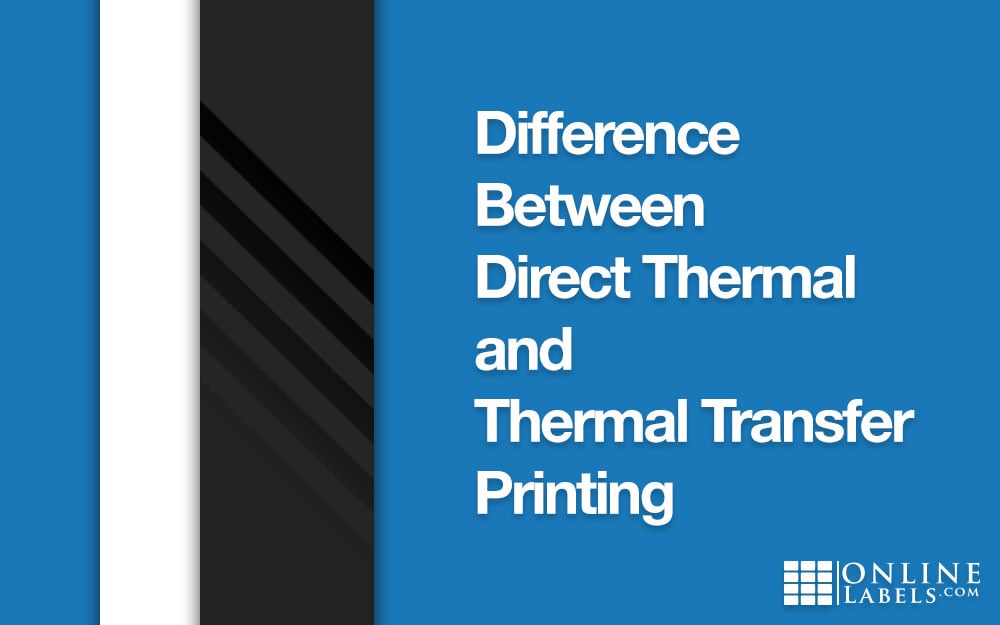Difference Between Direct Thermal and Thermal Transfer Printing

You may have questions as to which type of roll label is most suitable for your specific application. The information in this article will provide a basic understanding of the functionality and printing technologies used by direct thermal printers and thermal transfer printers, as well as the benefits, disadvantages, and required label materials for each.
Direct Thermal vs. Thermal Transfer Printers
The following video explores what makes the two roll printers different and how to easily identify which technology you're working with. You can also find a summary of how they work directly below.
Direct thermal printers utilize a thermal print-head to apply heat to your label paper. The facesheet on direct thermal labels is chemically treated to darken when warmed. Thus, your image is created in the path of the print-head. This functionality eliminates the need for ink, toner, or printing ribbons but results in a less-durable final product.
Thermal transfer printers use a thermal print-head, too, but the heat is applied to a wax or resin-based ribbon instead of the label. The ribbon ink is then pressed and absorbed into the label paper creating your print. Thermal transfer printers require that thermal ribbon to work, but the final product is much more durable as a result.
Direct Thermal Printers
Direct thermal printers utilize a chemically treated material that blackens when the thermal print-head applies heat to its surface.
Fast Facts
- Requires no ink, toner, or ribbons
- Prints in black and white only
- May fade over time
- Costs less than thermal transfer printers
- Needs little maintenance or replacement of supplies
- Not recommended for high-contact use
- Great for common barcode applications such as shipping labels, receipt labels, receipts, and nametag labels
Advantages
Because it uses heat to create the image, direct thermal printers don't require ink, toner, or ribbons. One of the benefits of this technology is the low maintenance costs — with fewer moving parts and pieces, there are fewer things that can go wrong. They're incredibly easy to operate and maintain.
Disadvantages
While there are many upsides to using a direct thermal printer, users should be aware of some constraints. Firstly, that the printed area will fade over time. Because the paper is heat-sensitive, additional heat or excessive light could cause the entire paper to darken. This could make the text unreadable and the barcodes unscannable. For this reason, direct thermal printing isn't recommended for long-term use.
Having said that, the printing technology still provides enough of a lifespan for many projects. Another limitation with direct thermal printers is their ability to only print in black and white. Where barcodes are fine with only black and white information, it doesn't allow for colored logos or graphics.
Popular Brands
There are two brands dominating the market today: DYMO® and Rollo®. Take a look at their costs, label options, and uses to make an informed decision for your small business.
Label Material Options
Shop Direct Thermal Labels
Thermal Transfer Printers
With thermal transfer printers, a thermal print-head applies heat to a wax or resin-based ribbon, which is melted to the label's surface. The ink is then absorbed into the label material.
Fast Facts
- Requires a ribbon for printing
- Can print in color with the addition of a colored ribbon
- Won't fade over time
- Durable enough to withstand chemicals and extreme temperatures
- Good for printing logos and graphics
- Compatible with a wide variety of materials
- Ideal for product identification, inventory labels, and asset labeling
Advantages
Because environmental factors will not alter the print quality, this type of technology is known to create an incredibly strong printed area that can withstand extreme temperatures and contact with chemicals. These printers are recommended for labels that need to last longer than six months.
An additional benefit of thermal transfer printing is the ability to print in color. With the purchase of a colored ribbon, you can print a logo, graphic, or text in the color of your ribbon. The color isn't specific to a graphic or individual block of text, however, the color applies to your entire label.
Thermal transfer printers also have the ability to accept a wider variety of material types than their direct thermal counterparts. We offer paper and polypropylene materials for both standard and weatherproof prints.
Disadvantages
One of the few downsides to thermal transfer printers is associated with the ribbons. They have to be replaced frequently to continue printing at a high quality. They are also more costly upfront.
Label Material Options
Shop Thermal Transfer Labels
FAQ
1. Which method is more affordable: direct thermal or thermal transfer printing?
Direct thermal printing is more affordable if you're looking for short-term label solutions since it doesn't use ink, toner, or printing ribbons. On the other hand, thermal transfer printing is not as affordable initially, but it may be more convenient in the long run for durable labels since it allows the user to decrease the need to print the labels more than once.
2. What are the most common use cases for direct thermal printing?
Direct thermal printers are typically better for temporary applications such as receipts, shipping labels, and scale labels.
3. What are the most common use cases for thermal transfer printing?
Thermal transfer printing is best for long-term projects like inventory management and barcode labeling.
4. Can I use any label material with both printing methods?
No, each printer requires a specific material.
5. Which method is better for barcode printing?
It all depends on the application. If you want your labels for short-term use, direct thermal labels are the best and most affordable solution. However, consider thermal transfer if the labels are meant for a longer lifespan.
6. How can I tell if my printer is direct thermal or thermal transfer?
Check the ribbon compartment. If the printer contains one, it is a thermal transfer printer. If not, it is a direct thermal printer.
7. Can I print in color using a direct thermal and a thermal transfer printer?
No, direct thermal printers only print black, and thermal transfer printers print on the ribbon's color, usually black.
The type of printer that you require will ultimately depend upon the nature of your application. Learn more about thermal transfer ribbons before making your decision. If you know what you want, start picking out your roll label shapes and sizes.



